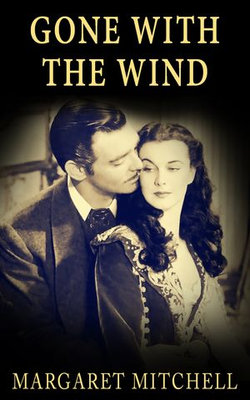Gone with the Wind is a novel written by Margaret Mitchell, first published in 1936. It is often placed in the literary sub-genre of the historical romance novel. However, it has been argued the novel is a "near miss" and does not contain all of the elements of the romance genre, making it simply a historical novel.
The story is set in Clayton County, Georgia, and Atlanta during the American Civil War and Reconstruction. It depicts the experiences ofScarlett O'Hara, the spoiled daughter of a well-to-do plantation owner, who must use every means at her disposal to come out of the poverty she finds herself in after Sherman's "March to the Sea".
Margaret Mitchell began writing Gone with the Wind in 1926 to pass the time while recovering from an auto-crash injury that refused to heal. In April 1935, Harold Latham of Macmillan, an editor who was looking for new fiction, read what she had written and saw that it could be a best-seller. After Latham agreed to publish the book, Mitchell worked for another six months checking the historical references, and rewrote the opening chapter several times. Mitchell and her husband John Marsh, a copy editor by trade, edited the final version of the novel. Mitchell wrote the book's final moments first, and then wrote the events that led up to it.
As to what became of her lovers, Rhett and Scarlett, after the novel ended, Mitchell did not know, and said, "For all I know, Rhett may have found someone else who was less difficult."
Mitchell received the Pulitzer Prize for Fiction for the book in 1937. The book was adapted into a 1939 American film. Gone with the Wind is the only novel by Mitchell published during her lifetime.
[Awards and recognition]
In 1937, Margaret Mitchell received the Pulitzer Prize for Fiction for Gone with the Wind and the second annual National Book Award from the American Booksellers Association. It is the second favorite book by American readers, just behind the Bible, according to a 2008 Harris Poll. The poll found the novel has its strongest following among women, those aged 44 or more, both Southerners and Midwesterners, both whites and Hispanics, and those who have not attended college. The novel is on the list of best-selling books. As of 2010, more than 30 million copies have been printed in the United States and abroad. TIME magazine critics, Lev Grossman and Richard Lacayo, included the novel on their list of the 100 best English-Language novels from 1923 to the present (2005). In 2003 the book was listed at number 21 on the BBC's The Big Read poll of the UK's "best-loved novel."
On June 30, 1986, the 50th anniversary of the day Gone with the Wind went on sale, the U.S. Post Office issued a 1-cent stamp showing an image of Margaret Mitchell. The stamp was designed by Ronald Adair and was part of the U.S. Postal Service's Great Americans series.
On September 10, 1998, the U.S. Post Office issued a 32-cents stamp as part of its Celebrate the Century series recalling various important events in the 20th century. The stamp, designed by Howard Paine, displays the book with its original dust jacket, a white Magnolia blossom, and a hilt placed against a background of green velvet.
To commemorate the 75th anniversary (May 2011) of the publication of Gone with the Wind in 1936, Scribner published a paperback edition featuring the book's original jacket art.
[Adaptations]
Gone with the Wind has been adapted several times for stage and screen:
- The novel is the basis of the Academy Award–winning 1939 film starring Clark Gable and Vivien Leigh.
- The book was adapted into a musical, Scarlett, which opened in Tokyo in 1970 (in 1966 it was produced as a nine hour play without music), and in London in 1972, where it was reduced to 4 hours. The London production opened in 1973 in Los Angeles, and again in Dallas in 1976.
- The Japanese Takarazuka Revue produced a musical adaptation of the novel, Kaze to Tomo ni Sarinu, which was performed by the all female Moon Troupe in 1994.
- There is a 2003 French musical adaptation by Gérard Presgurvic, Autant en Emporte le Vent.
- The book was adapted into a British musical, Gone with the Wind, and opened in 2008 in the U.K. at the New London Theatre.
- A full length three act classical ballet version with a score arranged from the works of Antonín Dvořák and choreographed by Lilla Pártay was premiered in 2007 by the Hungarian National Ballet, and will be revived in their 2013 season.




Share This eBook: